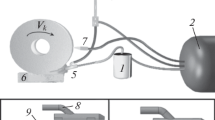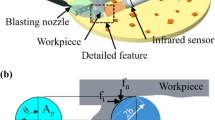Abstract
In this paper, the friction conditions of minimum coolant grinding (MCG) technology are deeply characterized. The MCG is a successful cooling/lubricating system that combines the application of minimum quantity of lubrication (MQL) and CO2 at low temperatures to create a frozen layer of oil able to reach the contact zone. This technique has previously shown promising results to reduce heat generation in grinding process and improve the workpiece finish. A comparison of the energy consumption, forces and wear patterns has been performed between MCG and dry grinding by means of the On-Machine Test Bench. In this work, authors have identified that MCG favours the shearing of the material reducing the energy consumption and wear of the abrasive. Differences are highlighted on the size of wear flats, the shape of the debris and the various types of wear mechanisms
Similar content being viewed by others
References
Hahn RS (1966) On the mechanics of the grinding process under plunge cut conditions. Trans ASME, J Eng Ind 72:80
Brinksmeier E, Heinzel C, Wittmann M (1999) Friction cooling and lubrication in grinding. Ann CIRP 48:2
Yoshikawa H, Sata T (1963) Study on wear of grinding wheels. J Eng Ind Trans ASME 85
Malkin S, Cook NH (1971) The wear of grinding wheels. Trans ASME J Eng Ind 84
Erickson LC, Blomberg A, Hogmark S, Bratthall J (1993) Tribological characterization of alumina and silicon carbide under lubricated sliding. Tribol Int 2:83–92
Zeng P, Rainforth WM, Inkson BJ, Stewart TD (2012) Transmission electron microscopy analysis of worn alumina hip replacement. Actar Materialia 60:2061–2072
Jackson MJ, Davim JP (2011) Machining with abrasives. Springer Science Business Media, LLC, New York
Irani RA, Bauer RJ, Warkentin A (2005) A review of cutting fluid application in the grinding process. Int J Mach Tools Manuf 45(15):1696–1705
Li C, Zhang X, Zhang Q, Wang S, Zhang D, Jia D, Zhang Y (2014) Modeling and simulation of useful fluid flow rate in grinding. Int J Adv Manuf Technol 75:1587–1604
Coes L Jr (1971) “Abrasives”. Springer-Verlag, New York, Chapter 14
Malkin S, Guo C (2008) Grinding technology—theory and applications of machining with abrasives. Industrial Press, New York
Winter M, Thiede S, Herrmann C (2014) Influence of the cutting fluid on process energy demand and surface roughness in grinding—a technological, environmental and economic examination. Int J Adv Manuf Technol DOI. doi:10.1007/s00170-014-6557-1
Ben Fredj N, Sidhom H, Braham C (2006) Ground surface improvement of the austenitic stainless steel AISI 304 using cryogenic cooling. Surf and Coat Tech 16–17:4846–4860
Nguyen T, Zhang L (2003) An assessment of the applicability of cold air and oil mist in surface grinding. J Mater Process Tech 140(1–3):224–230
Barczak LM, Batako DL, Morgan MN (2010) A study of plane surface grinding under minimum quantity lubrication (MQL) conditions. Int J Mach Tools Manuf 50:977–985
Davim JP (2008) Machining: fundamentals and recent advances. Volume 10. XIV, 361 p. 222 illus. Springer.
Zhang D, Li C, Zhang Y, Jia D, Zhang X (2015) Experimental research on the energy ratio coefficient and specific grinding energy in nanoparticle jet MQL grinding. Int J Adv Manuf Technol DOI. doi:10.1007/s00170-014-6722-6
Sanchez J, Pombo I, Alberdi R, Izquierdo B, Ortega N, Plaza S, Martinez-Toledano J (2010) Machining evaluation of a hybrid MQL-CO2 grinding technology. J Clean Prod 18(18):1840–1849
Garcia E, Pombo I, Sanchez JA, Ortega N, Izquierdo B, Plaza S, Marquinez JI, Heinzel C, Mourek D (2013) Reduction of oil and gas consumption in grinding technology using pour-point lubricants. J Clean Prod 51:99–108
Garcia E, Sanchez JA, Meresse D, Pombo I, Dubar L (2014) Complementary tribometers for the analysis of contact phenomena in grinding. J Mater Process Tech 214–9:1787–1797
Marinescu ID, Rowe WB, Dimitrov B, Inasaki I (2004) Tribology of abrasive machining processes. William Andrew Publishing
Bange D, Wood B, Erickson D (2001) Abras Mag June/July 24–30.
Marinescu I, Rowe B, Dimitrov B, Inasaki I (2004) Tribology of abrasive machining processes. J Manuf Sci Eng 126:859
Challen JM, Oxley PLB (1978) An explanation of the different regimes of friction and wear using asperity deformation models. Wear 53:229–243
Xie Y, Williams JA (1996) The prediction of friction and wear when a soft surface slides against a harder rough surface. Wear 196:21–34
Hecker RL, Liang SY, Wu XJ, Xia P, Wei Jin DG (2007) Grinding force and power modeling based on chip thickness analysis. Int J Adv Manuf Technol 33:449–459. doi:10.1007/s00170-006-0473-y
Oliveira JFG, Coelho RT, Neto CK (1999) Development of an optical scanner to study wear on the working surface of grinding wheels. Machin Sci Technol 3(2):239–253
Tso PL (1995) An investigation of chip types in grinding. J Mater Process Tech 53:521–532
Author information
Authors and Affiliations
Corresponding author
Rights and permissions
About this article
Cite this article
García, E., Méresse, D., Pombo, I. et al. Role of frozen lubricant film on tribological behaviour and wear mechanisms in grinding. Int J Adv Manuf Technol 82, 1017–1027 (2016). https://doi.org/10.1007/s00170-015-7397-3
Received:
Accepted:
Published:
Issue Date:
DOI: https://doi.org/10.1007/s00170-015-7397-3




